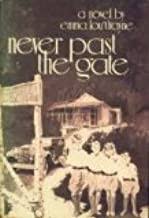Articles/Essays – Volume 10, No. 4
Canyon Eden | Emma Lou Thayne, Never Past the Gate
A serious novel about children usually is fascinating to adults. Emma Lou Thayne’s first novel, Never Past the Gate, is a zestful story with a mature theme. Ostensibly a lighthearted, nostalgic narrative of a family’s summer retreat, there are forebodings that this will be no ordinary symmer. It begins ordinarily enough in the summer of 1935. The Barton family (Father, Mother, hired girl Lena, Wid, James, Katie and Davy) are closing their Salt Lake City home for the annual move to their cabin in Armchair Canyon, twelve miles east of the city. They share the canyon with Mother’s extensive family. Over the years the move has become almost ceremonial. The most important ritual is performed as they enter the canyon—each cousin cuts a notch in the canyon side of the gate and solemly swears “never past the gate” until fall.
For ten-year-old Katie Barton this summer begins like all the others. She rediscovers old haunts, discovers new ones, reluctantly surrenders others. She and her brothers and cousins create the best underground hideout ever, its detection-proof entrance through the floor of an abandoned truck cab. They build “bugs” (go-carts) and manage one wild, clandestine ride the entire length of the canyon. Their activities are spiced with secrecy. Mr. Davis, the canyon gatekeeper mustn’t know about the bugs because they might damage his precious road. Mother has rigid ideas of propriety that require elaborate circumvention. Above all, the Enemy, an ominous unseen presence whose existence is revealed by the havoc he leaves in his path, must be thwarted.
Katie feels that she will love this summer best of all. At first her expectations are realized. Many of the familiar traditions resume: the 24th of July hike to the Armchair and evening bonfire; Father’s recital of the famous Old Hotel ghost story; Sunday School at Uncle Philip’s; school sessions with Mother, designed to keep the children out of certain predictable mischiefs. Slowly, Katie observes some troubling differences. Cousin Isabel inexplicably declines to remove her shirt according to custom on the big hike and develops a baffling interest in freckle cream. Wid has lost interest in building moss villages. Since Katie is at an age that regards growing up as the worst possible fate, these changes make her uneasy.
Another cause for uneasiness is a sense of unexpected evil in the canyon. Everyone knows there is danger—rattlesnakes, for one thing. But evil had existed mostly in attributing an omnipresent menace to sad, blunderous Daniel Moon. It becomes shockingly real in the person of Mr. Davis, the omniscient gatekeeper. Before the summer is over, some of Katie’s most frightening fantasies come alive. Snakebite, fire, suicide, disease and perversion have entered her experience. How she learns the difference between real evil and imagined evil is the central theme of the novel.
As my children would say, Never Past the Gate is a “wicked good” story. The lively antics of the Ruskin cousins are unfailingly entertaining. Katie is an appealing heroine, a beguiling mixture of tomboy and lady. The Barton family is close, warm and loving. At times the adult characters seem inhumanly wonderful. There is athletic, yarn-spinning Father with his easy sense of humor; a euphemistic, fearless Mother, controlled in crisis; a wise, understanding Grandma, reliable source of strength and comfort. Yet they are believable, well-drawn and likeable. Perhaps they seem better than life because we see them through Katie’s uncritical eyes. Children generally are oblivious to the faults in adults they love.
Mr. Davis is the exception in this gallery of lovable adults. His pleasantly sinister presence is not unbelievable early in the book. However, there isn’t sufficient motivation for his later transformation into a “dirty old man.” The scenes at the fire and in his cabin are unconvincing because they seem contrived for dramatic effect. In a book that is otherwise notable for its authenticity, the climax simply doesn’t ring true.
Emma Lou Thayne has a good ear for dialogue. Although she occasionally allows her young characters to speak a bit too poetically, these lapses are rare. She has the ability to take us into the children’s absorbing world. This canyon Eden comes complete with gates, serpents, and fire, and in Armchair Canyon these overworked symbols take on new power.
It is refreshing to read about Mormons who aren’t Mormons. The peculiarities of the Mormon faith are not dwelt upon. One feels that the Bartons differ from Southern Baptist Georgians or Congregational New Englanders in only minor detail. This affectionate portrayal of an exceptionally close-knit family that happens to be Mormon gives the book a universal resonance. Never Past the Gate holds the reader spellbound till the last day of summer.
Never Past the Gate, by Emma Lou Thayne. Peregrine Smith, 1975. 239 pp. $7.95.


 Back to full Issue
Back to full Issue

